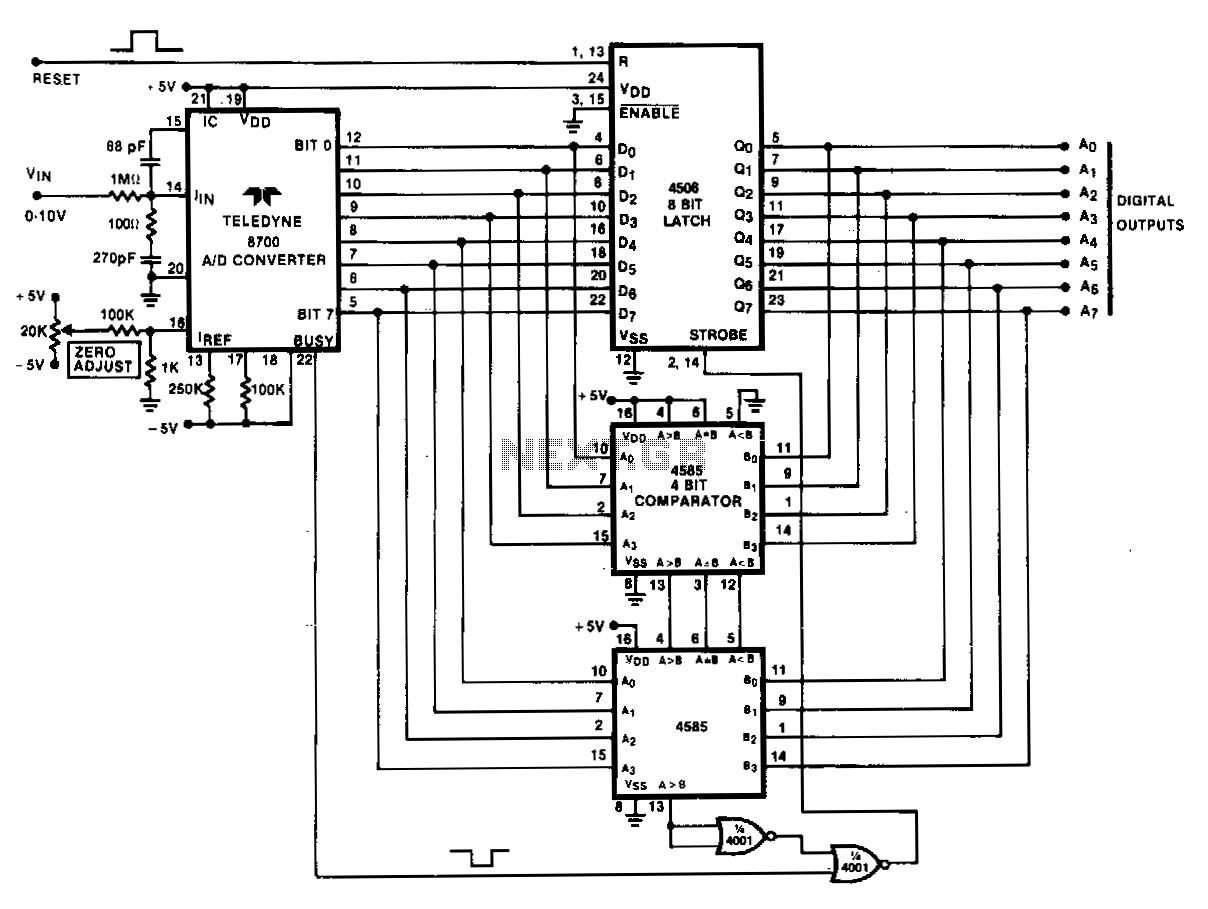
Analog-peak-detector-with-digital-hold

Analog peak detection is achieved by repeatedly measuring the input signal with an A/D converter and comparing the current reading with the previous reading. If the current reading is larger than the previous one, the current reading is stored in the latch and becomes the new peak value. Since the peak is stored in a CMOS latch, it can be retained indefinitely.
Analog peak detection is a crucial function in various electronic applications, particularly in signal processing and measurement systems. The process begins with an analog-to-digital (A/D) converter that samples the input signal at regular intervals. The A/D converter transforms the continuous analog signal into a discrete digital representation, allowing for easy manipulation and comparison.
The core of the peak detection mechanism lies in the comparison of successive readings. Each time a new sample is taken, it is compared to the previously stored peak value. If the new reading exceeds the stored peak, the latch updates its value to reflect this new peak. This comparison and storage process is executed rapidly, enabling the circuit to track the highest value of the input signal accurately.
The use of a CMOS latch for storing the peak value is particularly advantageous due to its low power consumption and ability to retain the stored data indefinitely, even when power is removed. This feature is essential for applications requiring long-term data retention without the need for continuous power supply, such as in battery-operated devices or systems where power availability is intermittent.
In practical implementations, additional components may be included to enhance the performance of the peak detection circuit. For instance, a filter might be integrated to reduce noise in the input signal, ensuring that only genuine peaks are detected. Furthermore, a reset mechanism could be added to allow the user to clear the stored peak value when necessary, facilitating repeated measurements in varying conditions.
Overall, the analog peak detection circuit represents a fundamental building block in electronic systems, providing essential functionality for monitoring and analyzing signal characteristics.Analog peak detection is accomplished hy repeatedly measuring the input signal with an a/d converter and comparing the current reading with the previous reading. If the current reading is larger than the previous, the current reading is stored in the latch and becomes the new peak value.
Since the peak is stored in a CMOS latch, the peak can be stored indefinitely. 🔗 External reference
Analog peak detection is a crucial function in various electronic applications, particularly in signal processing and measurement systems. The process begins with an analog-to-digital (A/D) converter that samples the input signal at regular intervals. The A/D converter transforms the continuous analog signal into a discrete digital representation, allowing for easy manipulation and comparison.
The core of the peak detection mechanism lies in the comparison of successive readings. Each time a new sample is taken, it is compared to the previously stored peak value. If the new reading exceeds the stored peak, the latch updates its value to reflect this new peak. This comparison and storage process is executed rapidly, enabling the circuit to track the highest value of the input signal accurately.
The use of a CMOS latch for storing the peak value is particularly advantageous due to its low power consumption and ability to retain the stored data indefinitely, even when power is removed. This feature is essential for applications requiring long-term data retention without the need for continuous power supply, such as in battery-operated devices or systems where power availability is intermittent.
In practical implementations, additional components may be included to enhance the performance of the peak detection circuit. For instance, a filter might be integrated to reduce noise in the input signal, ensuring that only genuine peaks are detected. Furthermore, a reset mechanism could be added to allow the user to clear the stored peak value when necessary, facilitating repeated measurements in varying conditions.
Overall, the analog peak detection circuit represents a fundamental building block in electronic systems, providing essential functionality for monitoring and analyzing signal characteristics.Analog peak detection is accomplished hy repeatedly measuring the input signal with an a/d converter and comparing the current reading with the previous reading. If the current reading is larger than the previous, the current reading is stored in the latch and becomes the new peak value.
Since the peak is stored in a CMOS latch, the peak can be stored indefinitely. 🔗 External reference